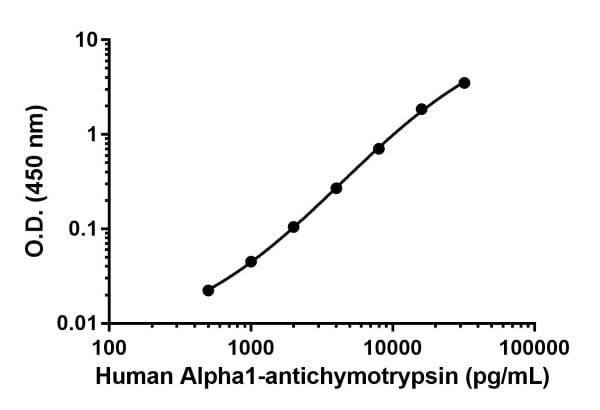Human AACT Matched Antibody Pair Kit (ab221445)
Key features and details
- Unlabeled capture antibody, biotin-labeled detection antibody and calibrated protein standard
- For economical ELISA and ELISA-based assay development
- Reacts with: Human
- Range: 500 pg/ml - 32000 pg/ml
Overview
-
Product name
Human AACT Matched Antibody Pair Kit
See all AACT kits -
Detection method
Colorimetric -
Assay type
ELISA set -
Sensitivity
77.4 pg/ml -
Range
500 pg/ml - 32000 pg/ml -
Species reactivity
Reacts with: Human -
Product overview
Human AACT Matched Antibody Pair Kits include a capture and a biotinylated detector antibody pair, along with a calibrated protein standard, suitable for sandwich ELISA. The Matched Antibody Pair Kit can be used to quantify native and recombinant human AACT.
Optimization of the kit reagents to sample type, immunoassay format or instrumentation may be required. Guidelines for use of this kit in a standard 96-well microplate sandwich ELISA using HRP/TMB system of colorimetric detection is described in this assay procedure for the purposes of quantification.
Protocol information and tips on the use of the Matched Antibody Pair kits for sandwich ELISA can be found on our website. An accessory pack can be purchased which includes buffer reagents required to perform 10 x 96-well plate sandwich ELISAs (ab210905).
For additional information on the performance of the antibody pair used in this kit, please see our equivalent SimpleStep ELISA kit ab217779. Please note that while the antibody pair is the same provided in the corresponding SimpleStep ELISA Kit, due to differences in their formulation, this antibody pair cannot be used with the consumables provided with our SimpleStep ELISA Kits.
-
Tested applications
Suitable for: ELISAmore details -
Platform
Reagents
Properties
-
Storage instructions
Store at -20°C. Please refer to protocols. -
Components 10 x 96 tests 5 x 96 tests Human AACT Detector Antibody 2 x 12.5µg 1 x 12.5µg Human AACT Lyophilized Protein 2 vials 1 vial Human AACT Capture Antibody 2 x 50µg 1 x 50µg -
Research areas
-
Function
Although its physiological function is unclear, it can inhibit neutrophil cathepsin G and mast cell chymase, both of which can convert angiotensin-1 to the active angiotensin-2. -
Tissue specificity
Plasma. Synthesized in the liver. Like the related alpha-1-antitrypsin, its concentration increases in the acute phase of inflammation or infection. Found in the amyloid plaques from the hippocampus of Alzheimer disease brains. -
Involvement in disease
Defects in SERPINA3 may be a cause of chronic obstructive pulmonary disease (COPD) [MIM:107280]. -
Sequence similarities
Belongs to the serpin family. -
Domain
The reactive center loop (RCL) extends out from the body of the protein and directs binding to the target protease. The protease cleaves the serpin at the reactive site within the RCL, establishing a covalent linkage between the carboxyl group of the serpin reactive site and the serine hydroxyl of the protease. The resulting inactive serpin-protease complex is highly stable. -
Cellular localization
Secreted. - Information by UniProt
-
Alternative names
- SERPINA3
- AACT
- AACT_HUMAN
see all -
Database links
- Entrez Gene: 12 Human
- Omim: 107280 Human
- SwissProt: P01011 Human
- Unigene: 534293 Human
- Unigene: 710488 Human
Images
-
Standard calibration curve. Background substracted values graphed.
-
To learn more about the advantages of recombinant antibodies see here.











